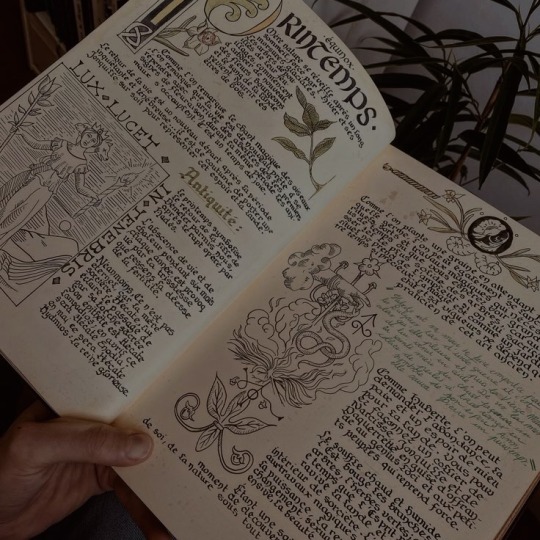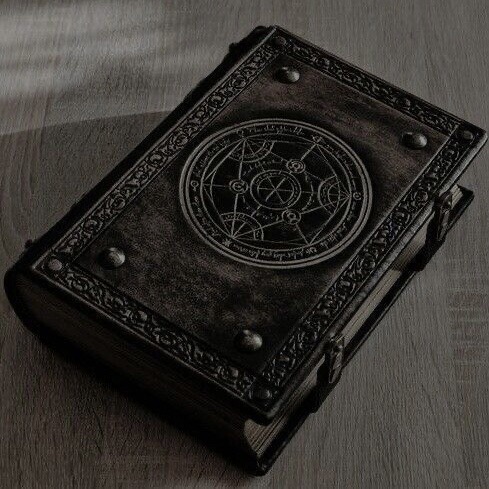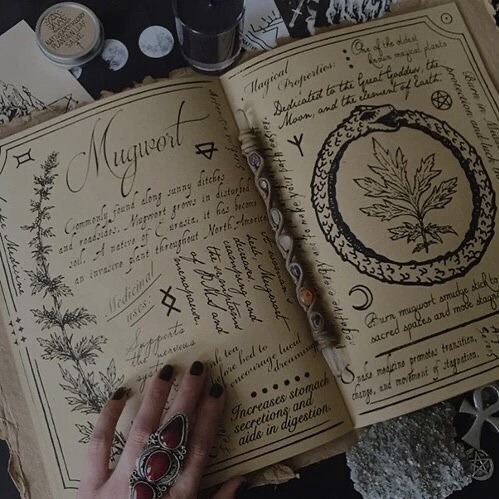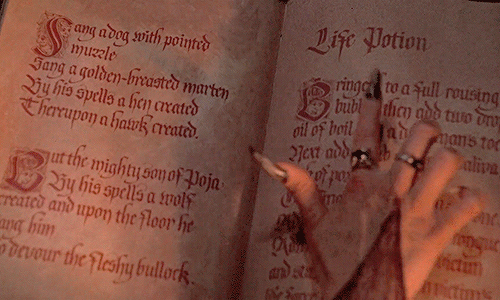#herbal tarot
Explore tagged Tumblr posts
Text
GRIMORE IDEAS



Start a lunar or dream diary.
Write spells.
Astrology meanings.
Write and record rituals
Tarot meanings.
Magickal correspondences.
Your natal chart info.
Herb names, uses, and/or properties.
Info about deities and entities.
Crystals names, uses, and/or properties.
Magickal food recipes.
Faeries.
Meditation techniques.
Full moon names.
Sigils.
Runes.
How to use a pendulum.
Wheel of the Year.
Essential oil uses.
How to scry.
Maiden, Mother, and Crone.
The Elements.
History of witchcraft.
The difference between jinxes, hexes, and curses.
Morning and night rituals.
How to celebrate/info about the Sabbats.
Types of salt and their properties.
Moon phases and their corresponding meanings.
Types of divination.
Planet correspondences.
Candle colour meanings.
How to draw and/or cast a circle, runes, and sigils.
Tools of the craft.
#fyp#fypシ#fypシ゚viral#fypage#fyppage#tumblr fyp#witchcraft#witches#witch#herbal witch#crystal witch#witchcore#witch community#learning witchcraft#grimoire#ideas#sabbats#divination#moon phases#norse runes#sigils#wheel of the year#faeries#crystals#herbs#spellwork#spells#tarot cards#astrology#information
2K notes
·
View notes
Text

While shuffling the tarot cards I meditated on Venus and Cancer. I was surprised when the first two cards I pulled were exactly two that were in my last reading I did on the Summer Solstice. Venus is retrograding and going back to re-visit this new energy that got sparked on the Solstice. On this re-visit we will now find that spark has grown into a very well established fire. Passion. A forward fire-y Ambition meets retrograding Venus. An old flame re-kindled? A Passion being Re-considered?
Regardless, this return to the house of Cancer isn’t an easy one though because it requires Venus to go back over the Cancer/Leo Gandanta knot which predicts a possible bumpy ride for the summer astrological forecast in regards to love & money. So hold onto your heart & wallet and spend cautiously until you can be a confident spender. Which won’t happen until Venus starts to go forward again.
IV The Emperor - 🔥 Aries, Mars, Energy & Strength. A masculine figure who goes out to conquer and acquire what he wants.
Atractylodes Macrocephala - Bai Zhu in Herbal Chinese Medicine -
( (macro = big , cephal = head) 😂 Is Herbalist Tierra making a joke about our emperor ? ) Moves Qi
0 notes
Text
𝖀𝖓𝖉𝖊𝖗𝖘𝖙𝖆𝖓𝖉𝖎𝖓𝖌 & 𝖀𝖘𝖎𝖓𝖌 𝕸𝖆𝖌𝖎𝖈𝖆𝖑 𝕮𝖔𝖗𝖗𝖊𝖘𝖕𝖔𝖓𝖉𝖊𝖓𝖈𝖊𝖘

Witchcraft magical correspondences refer to the associations made between various objects, substances, times, and events with specific magical effects or purposes. These correspondences have deep historical roots and derive from a blend of multiple sources, including ancient alchemy, early science, cultural symbolism, religious beliefs, and intentionality.
Ancient Alchemy
Alchemy, the precursor to modern chemistry, played a significant role in shaping magical correspondences. Alchemists sought to understand the mysteries of matter and the transformation of substances, often imbuing their experiments with spiritual and mystical significance. For example, the seven classical planets (Sun, Moon, Mercury, Venus, Mars, Jupiter, and Saturn) were associated with specific metals (gold, silver, mercury, copper, iron, tin, and lead, respectively). These associations were believed to reflect the planets’ influences on earthly matters and human affairs. Alchemical texts also explored the relationships between colors, elements, and spiritual principles, influencing the development of magical correspondences in witchcraft.
Ancient alchemy holds a significant place in the history of science, philosophy, and mystical traditions, influencing various fields and practices, including witchcraft. The importance of ancient alchemy can be understood through its contributions to the development of modern science, its philosophical and spiritual dimensions, and its enduring influence on magical and esoteric traditions.
The Great Work (Magnum Opus): Central to alchemy is the concept of the Great Work, which symbolizes the alchemist’s quest for spiritual and material transformation. This process involves the purification and perfection of substances, often mirroring the alchemist’s inner spiritual journey toward enlightenment and self-realization.
Symbolism and Allegory: Alchemical texts are rich in symbolism and allegory, using metaphors to convey complex philosophical and spiritual concepts. Symbols such as the philosopher’s stone, the ouroboros (a serpent eating its own tail), and the four elements (earth, air, fire, water) encapsulate profound ideas about the nature of reality, transformation, and the interconnectedness of all things.
Hermetic Tradition: Alchemy is closely associated with Hermeticism, a philosophical and spiritual tradition based on the writings attributed to Hermes Trismegistus. Hermetic principles, such as “As above, so below” and the unity of opposites, permeate alchemical thought and emphasize the correspondence between the macrocosm (the universe) and the microcosm (the individual).
Magical Correspondences: Alchemical principles and symbols have been integrated into various magical and esoteric traditions. The associations between planets, metals, and elements in alchemy have become foundational correspondences in many forms of magic and witchcraft.
Transmutation and Transformation: The alchemical goal of transmutation, particularly the transformation of base metals into gold, has a symbolic counterpart in magical practices. This idea of transformation is applied to personal growth, healing, and the manifestation of desires through magical means.
Ritual and Practice: Alchemical rituals, with their focus on purification, transformation, and the attainment of higher states of being, have influenced the structure and content of magical rituals. The use of specific substances, tools, and processes in alchemy has parallels in magical workings, emphasizing the transformation of both the practitioner and the environment.
Alchemy in the Renaissance: During the Renaissance, alchemy experienced a revival as scholars and practitioners sought to integrate ancient wisdom with emerging scientific knowledge. Figures like Paracelsus and John Dee contributed to the development of alchemical thought, blending it with medicine, astrology, and early chemistry.
Psychological Alchemy: In the 20th century, Carl Jung, a prominent psychologist, explored alchemy as a metaphor for psychological processes. Jung’s interpretation of alchemical symbolism as representing the individuation process—the integration of the conscious and unconscious mind—brought new insights into the relevance of alchemy for personal development and psychotherapy.
Contemporary Practice: Today, alchemy continues to inspire both scientific inquiry and spiritual exploration. Modern alchemists, both literal and symbolic, seek to uncover the hidden principles of transformation in nature and the self. The enduring appeal of alchemy lies in its holistic approach, integrating material, psychological, and spiritual dimensions of existence.
Early Science and Natural Philosophy
Early scientific observations and natural philosophy also contributed to the development of magical correspondences. Ancient and medieval scholars often categorized the natural world into elements (earth, air, fire, and water) and humors (blood, phlegm, yellow bile, and black bile), each with specific qualities and effects. These classifications were used to explain natural phenomena and human health, and they found their way into magical practices. For instance, herbs and stones were categorized based on their perceived elemental qualities, and their uses in magic were aligned with these characteristics.
Cultural Symbolism and Mythology
Cultural symbolism and mythology provided another rich source of correspondences. Different cultures imbued animals, plants, colors, and objects with symbolic meanings based on their myths, legends, and folklore. For instance, the oak tree was sacred to many ancient European cultures and associated with strength and protection, while the owl, often seen as a symbol of wisdom in Greek mythology, became associated with knowledge and divination in magical practices. These symbolic associations were passed down through generations and integrated into the magical correspondences of witchcraft.
Religious Beliefs and Practices
Religious beliefs and practices also shaped magical correspondences. Many magical traditions borrowed from the rituals and symbols of dominant religious practices in their regions. In Western Europe, for instance, Christian symbols and saints were often syncretized with older pagan deities and symbols. The use of incense, candles, and specific prayers or chants in magic often mirrors religious rituals, emphasizing the importance of intentionality and spiritual alignment in magical workings.
Intentionality and Personal Experience
The role of intention and personal experience cannot be overlooked in the development of magical correspondences. Practitioners of witchcraft often develop their own associations based on personal experiences, intuition, and the results of their magical workings. This process of individual experimentation and reflection allows for a dynamic and evolving system of correspondences that can vary between different traditions and practitioners. The intention behind the use of a correspondence is believed to be a critical factor in its effectiveness, highlighting the importance of the practitioner’s focus and purpose.
Synthesis and Evolution
Over time, these diverse influences have synthesized into the rich tapestry of magical correspondences used in witchcraft today. Texts such as the “Key of Solomon,” “The Picatrix,” and various grimoires have codified many of these correspondences, while modern practitioners continue to adapt and expand them based on contemporary understanding and practice. The integration of psychological insights, ecological awareness, and cross-cultural exchanges in the modern era further enriches the system of correspondences, making it a living and evolving aspect of witchcraft.
No single person or group decided these correspondences; rather, they evolved organically through the accumulated wisdom and practices of different cultures. Here are some key influences and sources:
Ancient Civilizations
Egyptians: Ancient Egyptian priests and magicians developed extensive knowledge of correspondences. They believed that everything in nature was interconnected and that specific plants, stones, and symbols held particular powers. Their practices were recorded in texts like the Ebers Papyrus and various temple inscriptions.
Greeks and Romans: The Greeks and Romans contributed significantly to the development of correspondences, particularly through the work of philosophers and physicians like Hippocrates, Theophrastus, and Pliny the Elder. Their writings on herbalism, astrology, and natural philosophy helped establish connections between natural elements and their supposed properties.
Celts: The Druids of the Celtic world had a deep understanding of nature and used various plants, trees, and natural phenomena in their spiritual and magical practices. Their knowledge was passed down orally and later recorded by Christian monks.
Medieval and Renaissance Europe
Medieval Herbalists and Alchemists: During the Middle Ages, herbalists and alchemists in Europe studied ancient texts and conducted their own experiments. They documented the properties of plants, minerals, and metals in texts like the “Materia Medica” and various grimoires. Alchemical traditions, which sought to transform base materials into higher forms, also contributed to the understanding of correspondences.
Astrology: Medieval and Renaissance astrologers played a significant role in establishing correspondences, particularly through the association of planets with specific days of the week, metals, and plants. The writings of figures like Ptolemy and later Renaissance magicians like Cornelius Agrippa and Paracelsus were influential in this regard.
Eastern Traditions
Chinese Medicine and Taoism: Traditional Chinese medicine and Taoist practices developed a system of correspondences based on the Five Elements (Wood, Fire, Earth, Metal, Water). These elements were connected to various aspects of life, including organs, emotions, seasons, and directions. The “Huangdi Neijing,” an ancient Chinese medical text, is a key source of this knowledge.
Indian Ayurveda and Hinduism: Ayurvedic medicine and Hindu spiritual practices established correspondences between herbs, gems, times of day, and deities. Texts like the “Atharva Veda” and various Ayurvedic treatises documented these associations.
Modern Influences
Grimoires and Occult Literature: From the Renaissance onward, numerous grimoires (books of magic) compiled and expanded upon earlier correspondences. Notable examples include the “Key of Solomon,” “The Lesser Key of Solomon,” and “The Picatrix.” These texts were influential in shaping modern Western magical practices.
The Golden Dawn and Modern Witchcraft: In the late 19th and early 20th centuries, the Hermetic Order of the Golden Dawn and similar occult organizations synthesized various magical traditions, creating detailed systems of correspondences. Influential figures like Aleister Crowley and Dion Fortune contributed to this synthesis. In the mid-20th century, Gerald Gardner and others who founded modern Wicca drew upon these traditions, further popularizing and systematizing magical correspondences.
Conclusion
Magical correspondences are the result of centuries of observation, experimentation, and synthesis by various cultures and traditions. They were not decided by any single individual or group but evolved over time through the collective wisdom of countless practitioners. Today, they continue to be an essential part of many magical and spiritual practices, providing a framework for understanding and working with the interconnectedness of the natural and spiritual worlds.
#divination#free tarot readings#spirituality#witchblr#tarot#witch#witchcraft#high priestess house#witch community#astrology#eclectic witch#correspondences#witch history#witches of tumblr#occult history#occultism#occult#witchy vibes#witchcore#witch aesthetic#baby witch#witches#witchcraft 101#moon witch#witchy#alchemy#psychology#herbalism#herbalmedicine#alchemist
435 notes
·
View notes
Text



//slow living//
#slow living#slow life#sustainability#sustainable#aesthetic#spirituality#tarot#90s runway#divination#90s supermodels#cozycore#nature#girlblogger#self care#spiritual girl#spiritualgrowth#granola girl#clean girl#soft girl#earthy girl#vanilla girl#it girl#girly stuff#dream girl#dream#cottagecore#cottage aesthetic#off the grid#herbalism#herbs
143 notes
·
View notes
Text




Ей нравилось смотреть на бледно-розовое и золотистое утреннее небо за церковным шпилем, на полупрозрачное пламя восхода, разгорающееся над вспаханными полями, на первые лиловые спирали дыма, поднимающиеся с деревенских крыш.
#NatureLovers#NatureWalks#VillageVibes#witch#aestethic#photo#aesthetic#forest witch#cottagecore#cottage living#redhead#nature#русский тамблер#русский текст#русский tumblr#witches#witchcraft#spirituality#magic#herbalism#tarot#divination#occult#spellwork#witchyvibes#осень#autumn atmosphere#autumn#september magic
69 notes
·
View notes
Text
Herbs and Their Purposes
Going through some of my witchy journals and sharing things that I have collected over the years.
Amaranth: reduces swelling, helps stomach flu symptoms, repairs broken hearts Angelica: aids colic, helps hepatitis symptoms, protects your home and garden Basil: eases stomach cramps, eases insect bites and stings, helps reduce fevers, banishes negativities, aids in keeping love Bee Balm: makes a sedative tea, attracts fairies Calendula: helps gum disease, encourages psychic development Chamomile: helps insomnia, eases sores, attracts money, protects home, aids meditation Comfrey: heals wounds, bruises, and broken bones, provides travel protection Daisy: helps headaches, brings good luck Dandelion: detoxifies liver, promotes circulation, aids clairvoyance Eucalyptus: works as insect repellent, aids health, provides purification Garlic: works as a natural anti-biotic, dispels negativity, protects the house Heather: suppresses coughs, aids sleep, guard against violent crime Hyssop: aids lung ailments, used in purification baths Lavender: eases nervous tension and stress, used in healing incenses and sachets Lemon Balm: eases bee stings, headaches and colds, used in healing and friendship spells Marjoram: helps asthma symptoms, cough, strengthens intestines, eases grief, protects home Myrrh: works as a powerful antiseptic, used to consecrate and purify ritual tools Patchouli: eases dysentery, diarrhea, and nausea, wards off evil Rose: nourishes skin, purifies blood, aids in love spells Sage: eases laryngitis symptoms and stomach troubles, aids in spiritual purification, banishes evil Soloman's Seal: helps tuberculosis symptoms, helps diabetes symptoms, used in cleansing Spearmint: makes a facial astringent, used in spells for courage Star Anise: eases stomach disorders, wards off evil eye St. John's Wort: helps depression symptoms, heals wounds, banishes negativity Thyme: used as an antiseptic, if used in a pillow it wards of nightmares Witch Hazel: eases insect bites and burns, twigs used for diving, mends broken hearts Wormwood: helps ease liver and bladder symptoms, aids clairvoyance Yarrow: stimulates the liver, eases toothache, wards off negativity, repels fear Yellow Dock: purifies blood, aids in spells for happy homes
****DISCLAIMER**** Do NOT take internally with out a doctor's supervision. Misuse can be FATAL. Do not ingest if allergic. Please see a doctor for all ailments described above.
#witchy#witch craft#herbs#herbal uses#herbs & spices#kitchen witch#herbal remedies#wicca#wiccan#herb uses#witch community#witchblr#witch craft community#tarot#tarot community#tarotblr#tarot cards#divination#tarot witch
52 notes
·
View notes
Text

- The Love Witch (2016)
#the love witch#witchcraft#witchblr#lunar witch#divination#glamour magic#aphrodite#lady aphrodite#feminism#whimsigoth#whimsigothic#candles#trinkets#this is a girlblog#girl blogger#girl blogging#herbalism#maximalism#maximalist fashion#green witch#baby witch#magick#soft goth#tarot#tarotblr#tarot cards#crystals#rose quartz#rose water#spellcasting
123 notes
·
View notes
Text
Need more active blogs to follow :)
Please interact if you post:
• Witchy aesthetic photos
• Witchcraft resources/tips
• Green magic/Earth related magic
• Herbalism/Botany
• Divination of any kind
• Shadow work
• Love/Glamour magic
• Aphrodite (But any Greek pantheon related stuff is welcome, too)
• Occult related aesthetic or resources
• Witchcraft history/traditional/folk
• Honestly, anything witchy!! Just needing more active blogs to follow.
Give a follow back if you like a mix of all of those things :) My blog is a little more about my personal growth/stories/spells/readings, but I’m mostly just reblogging others.
#witchcraft#witch#green witch#pagan#folk magick#witchy#witchy aesthetic#baby witch#love witch#glamour witch#divination#tarot#shadow work#grimoire#book of shadows#witch tips#herbalism#botany#Greek gods#occult#occultism#wicca#eclectic witch#witchblr#witches#witch aesthetic#beginner witch#pagan witch#witches of tumblr#witch community
40 notes
·
View notes
Text
I'm in the process of reviving this 4 years dead blog, so it looks kind of empty from no recent posts. I need to update my bio and stuff but mainly I'm interested in following people who talk about witchcraft, herbalism, sustainability, and tarot!
21 notes
·
View notes
Text









https://foragewitch.tumblr.com/ fairyquests.tumblr.com sliwkitty94.tumblr.com https://gardenist.tumblr.com/ https://www.tumblr.com/flauschigehummel https://wayfind-er.tumblr.com/ https://lostghostdust.tumblr.com/ https://www.tumblr.com/ye-spirits
Some witchy themed blogs for you ^
#witch#witchcraft#pagan#magick#witchy#tarot#witchyvibes#wicca#witches#herbalism#witchythings#spirituality#witchlife#occult#spiritual#wiccan#paganism#witchaesthetic#spells#goth
8 notes
·
View notes
Text
Notion Grimoire Template (available in dark & light mode!)

I spent the better part of a year perfecting and finalizing my own personal Notion Grimoire, and thought it would be a great resource for new & experienced witches alike!




This template is chock-full of databases and templates to put in your own information - and I have also added a few pages that are already filled out!


You can purchase this template from my Etsy in light or dark mode, and you can use the code "IGOTCHU" for 20% off!
#thevirginwitch#witchcraft#witch#witchblr#witchy#witches of tumblr#pagan#tarot#beginner witch#grimoire#book of shadows#digital grimoire#digital bos#digital book of shadows#notion#astrology#spells#spell book#herbalism#herb magic#magic#baby witch#witch community#witchy tips#witch blog#notion template#notion grimoire#notion templates#chaos magic#magick
49 notes
·
View notes
Text

The Herbal Tarot reading for the week of July 2. Vedic Astrology: Mars just getting through the gandanta knot of transist from Camcer to Leo. Exhausted from this trip but glad to have finally arrived at our new sunny location. ( I personally have been strongly feeling this knotted energy. ) We will soon feel the bon aire of this new positive energy in this new light environment. A revival is on the horizon :)
Five of Pentacles - every time I see this card I immediately think ‘ugh.’ And the very reason I decided to do a reading this evening was because I have been feeling this ‘ugh.’ Cold. Down & out. Limited. Struggle. Mugwort - powerful & potent bitter
The Sun X1X - all giving Angelica - revered tonic
Page of Swords - new young playful spirit & energy. Dill - gentle carminative - spleen qi - solar plexus
1 note
·
View note
Text
Organizing my 2024 herbs roots and flowers into jars and easier access (spice drawer, tea shelf, spell drawer, etc) for Imbolc



#green witch#kitchen witch#pagan#witch#witchcraft#herbs#herbalism#half the teas i got for free from a local herb store through gleaners the other half i mixed#almost all the herbs roots and flowers are mine tho#the little mini shelves have my flowers and tarot cards and things#i have a separate wooden box of roots for teas like blackberry cannabis mallow#imbolc
10 notes
·
View notes
Text

May your ancestral communications be clear and healing these Dias de Los Muertos 🤍 I did some cleansing work last night using a space cleansing chime candle I make. The candle is made with beeswax, soy wax, and Sage, Patchouli, Bergamot, and Lavender essential oils. I dressed it with Lemon essential oil and the herbs I used. The intentional herbs that I chose to help cleanse and balance my space while inviting forward and honoring my ancestors include Itzayahuatl, Rosemary, Mugwort, Cinnamon, and Jasmine. I also used small chunks of pink Himalayan salt to represent the 4 directions, so my intention would flow clearly through each direction 🌊 I cleansed my spellwork plate beforehand with Agua de Florida, Copal, and Palo Santo to invite warm and loving energies. I also cleansed myself with the Copal and Palo Santo 💗
#bruja#brujeria#spirituality#tarot#sea witchcraft#south texas#spellwork#limpias#depop#etsy#ecletic witch#eclectic witchcraft#witchblr#witchcraft#sea witch#ocean witch#herbalism#herbs#green witch#green witchcraft#candles#handmade candles#altar
86 notes
·
View notes

